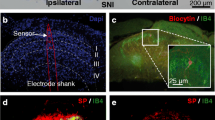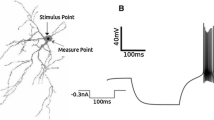Summary
In 9 adult anaesthetized cats, 22 lumbosacral Renshaw cells recorded with NaCl-filled micropipettes were activated by random stimulation of ventral roots or peripheral nerves. The stimulus patterns had mean rates of 9.5~13 or 20–23 or 45 pulses per second and were pseudo-Poisson; short intervals below ca. 5 ms (except in two cases) were excluded. The Renshaw cell responses were evaluated by two kinds of peristimulus-time histograms (PSTHs). “Conventional” PSTHs were calculated by averaging the Renshaw cell discharge with respect to all the stimuli in a train. These PSTHs showed an early excitatory response which was often followed by a longer-lasting slight reduction of the discharge probability. These two response components were positively correlated. “Conditional” PSTHs were determined by averaging the Renshaw cell discharge with respect to the second (“test” stimulus in pairs of stimuli which were separated by varied intervals, δ. The direct effect of the first “conditional” response was subtracted from the excitation following the second (“test” stimulus so as to isolate the effect caused by the second stimulus per se. After such a correction, the effect of the first “conditioning” stimulus showed pure depression, pure facilitation or mixed facilitation/depression. Analysis of such conditioning curves yielded two time constants of facilitation (ranges: ca. 4–35 ms and 93–102 ms) and two of depression (ranges: ca. 7–25 ms and 50–161 ms). It is concluded that these time constants are compatible with processes of short-term synaptic plasticity known from other synapses. Other processes such as afterhyperpolarization and mutual inhibition probably are of less importance.






Similar content being viewed by others
References
Allum JHJ, Dietz V, Freund HJ (1978) Neuronal mechanisms underlying physiological tremor. J Neurophysiol 41: 557–571
Andreassen S, Rosenfalck A (1980) Regulation of the firing pattern of single motor units. J Neurol Neurosurg Psychiat 43: 897–906
Balnave RJ, Gage PW (1970) Temperature sensitivity of the time course of facilitation of transmitter release. Brain Res 21: 297–300
Bawa P, Calancie B (1983) Repetitive doublets in human carpi radialis muscle. J Physiol (Lond) 339: 123–132
Betz WJ (1970) Depression of transmitter release at the neuromuscular junction of the frog. J Physiol (Lond) 206: 629–644
Čapek R, Esplin B (1977) Homosynaptic depression and transmitter turnover in spinal monosynaptic pathway. J Neurophysiol 40: 95–105
Christakos CN (1982) A study of the muscle waveform using a population stochastic model of skeletal muscle. Biol Cybern 44: 91–106
Christakos CN, Windhorst U, Rissing R, Meyer-Lohmann J (1987) Frequency response of spinal Renshaw cells activated by stochastic motor axon stimulation. Neuroscience 23: 613–623
Christensen BN, Martin AR (1970) Estimates of probability of transmitter release at the mammalian neuromuscular junction. J Physiol (Lond) 210: 933–945
Collins WF III, Honig MG, Mendell LM (1984) Heterogeneity of group Ia synapses on homonymous α-motoneurons as revealed by high-frequency stimulation of Ia afferent fibers. J Neurophysiol 52: 980–993
Curtis DR, Eccles JC (1960) Synaptic action during and after repetitive stimulation. J Physiol (Lond) 150: 374–398
Eccles JC, Eccles RM, Iggo A, Lundberg A (1961) Electrophysiological investigations on Renshaw cells. J Physiol (Lond) 159: 461–478
Elble RJ, Randall JE (1976) Motor-unit activity responsible for 8- to 12-Hz component of human physiological finger tremor. J Neurophysiol 39: 370–383
Haase J (1963) Die Transformation des Entladungsmusters der Renshaw-Zellen bei tetanischer antidromer Reizung. Pflügers Arch ges Physiol 276: 471–480
Hamm TM, Sasaki S, Stuart DG, Windhorst U, Yuan C-S (1987) Distribution of single-axon recurrent inhibitory post-synaptic potentials in a single spinal motor nucleus in the cat. J Physiol (Lond) 388: 653–664
Hultborn H, Pierrot-Deseilligny E (1979) Input-output relations in the pathway of recurrent inhibition to motoneurones in the cat. J Physiol (Lond) 297: 267–287
Kuno M (1964) Mechanism of facilitation and depression of the excitatory synaptic potential in spinal motoneurones. J Physiol (Lond) 174: 100–112
Magleby KL (1973) The effect of repetitive stimulation on facilitation of transmitter release at the frog neuromuscular junction. J Physiol (Lond) 234: 327–352
Mallart A, Martin AR (1967) An analysis of facilitation of transmitter release at the neuromuscular junction of the frog. J Physiol (Lond) 193: 679–694
McNaughton BL (1980) Evidence for two physiologically distinct perforant pathways to the fascia dentata. Brain Res 199: 1–19
Ross H-G, Cleveland S, Haase J (1975) Contribution of single motoneurons to Renshaw cell activity. Neurosci Lett 1: 105–108
Ryall RW (1970) Renshaw cell mediated inhibition of Renshaw cells: patterns of excitation and inhibition from impulses in motor-axon collaterals. J Neurophysiol 33: 257–270
Ryall RW (1981) Patterns of recurrent excitation and mutual inhibition of cat Renshaw cells. J Physiol (Lond) 316: 439–452
Silinski EM (1985) The biophysical pharmacology of calcium-dependent acetylcholine secretion. Pharmacol Rev 37: 81–132
Thies RE (1965) Neuromuscular depression and the apparent depletion of transmitter in mammalian muscle. J Neurophysiol 28: 423–442
van Keulen L (1981) Autogenetic recurrent inhibition of individual spinal motoneurones of the cat. Neurosci Lett 21: 297–300
Walmsley B, Tracey DJ (1981) An intracellular study of Renshaw cells. Brain Res 223: 170–175
Windhorst U (1988) How brain-like is the spinal cord? Interacting cell assemblies in the nervous system. Springer, Berlin Heidelberg New York Tokyo
Windhorst U, Niemann U, Koehler W (1983) Analsyis of nonlinear physiological systems with single or multiple spike inputs and analogue or spike outputs. Biol Cybern 48: 159–163
Windhorst U, Rissing R, Meyer-Lohmann J (1987) After-effects of stochastic synaptic Renshaw cell excitation on their discharge probability. Brain Res 408: 289–294
Acknowledgement
This work was partly supported by the Deutsche Forschungsgemeinschaft, SFB 33 (“Nervensystem und biologische Information”) Göttingen. We are grateful to Mrs. B. Müller-Fechner and Mrs. U. deBuhr for technical assistance.
Author information
Authors and Affiliations
Rights and permissions
About this article
Cite this article
Laouris, Y., Windhorst, U., Rissing, R. et al. Time constants of facilitation and depression in Renshaw cell responses to random stimulation of motor axons. Exp Brain Res 72, 117–128 (1988). https://doi.org/10.1007/BF00248506
Received:
Accepted:
Issue Date:
DOI: https://doi.org/10.1007/BF00248506




